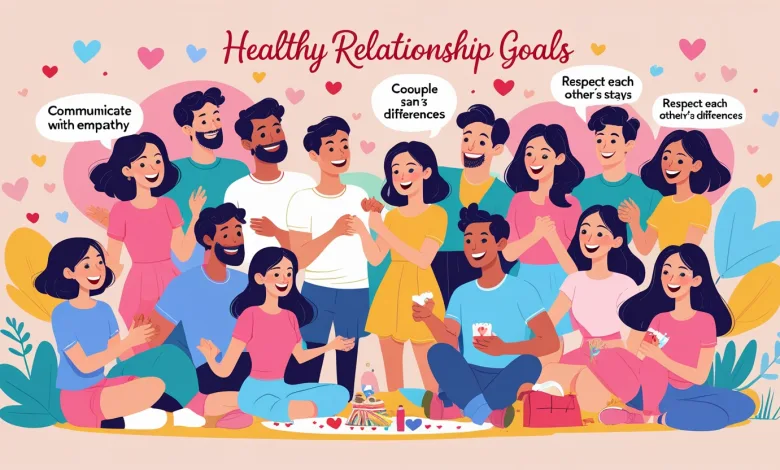What Are the Examples of Relationship Goals?

In a world obsessed with picture-perfect couples on Instagram, authentic relationship goals focus on building genuine connection, trust, and mutual growth. Let’s explore what truly matters in creating a fulfilling partnership.
The Reality Behind Relationship Goals in Today’s World
We’ve all seen those perfectly curated Instagram posts: the surprise proposal atop a mountain, elaborate anniversary gifts, and candlelit dinners with the caption “#RelationshipGoals.” But let’s get real—true relationship goals extend far beyond these filtered moments.
Genuine relationship goals aren’t just about grand gestures that photograph well. They’re about the everyday moments, the challenging conversations, and the commitment to grow together through life’s ups and downs. When we ask “what are the examples of relationship goals?” we should focus on aspirations that foster authentic connection rather than social media approval. According to relationship therapist Dr. John Gottman, couples who maintain happy, long-term relationships focus on building friendship, managing conflict effectively, and creating shared meaning—not on creating Instagram-worthy moments.
Foundational Relationship Goals for Every Couple
Effective Communication Practices
Communication isn’t just talking—it’s about how we talk, listen, and understand each other. Healthy couples make it a priority to communicate openly, honestly, and respectfully, even during disagreements.
One concrete relationship goal is establishing regular check-ins with your partner. This might be a weekly “relationship state of the union” where you discuss what’s working well and what needs attention. Another goal is practicing active listening—truly focusing on understanding your partner’s perspective rather than formulating your response while they’re still speaking. Research from the University of California found that couples who practice active listening report 31% higher relationship satisfaction.
Building Unwavering Trust
Trust isn’t built overnight—it’s established through consistent actions that demonstrate reliability, honesty, and respect for boundaries. When partners follow through on commitments, big or small, they’re actively working toward this relationship goal.
Setting trust-related goals might include being transparent about finances, honoring each other’s privacy, or refusing to use past mistakes as ammunition during arguments. Trust also involves giving your partner the benefit of the doubt rather than jumping to negative conclusions about their intentions. According to a study published in the Journal of Personal and Social Relationships, couples who practice “positive attributions”—assuming good intentions from their partner—report higher relationship satisfaction and longevity.
Growth-Oriented Relationship Goals
Supporting Individual Development
The healthiest relationships don’t just nurture the partnership—they encourage individual growth too. This means supporting your partner’s personal goals, interests, and friendships outside the relationship.
Concrete goals might include scheduling regular “me time” for both partners, encouraging each other to pursue hobbies and interests, or celebrating individual achievements. Psychologist Dr. Esther Perel notes that maintaining some separateness actually fuels desire and connection in long-term relationships. She explains, “Fire needs air. Desire needs space.”.
Evolving Together Through Challenges
Life throws curveballs—job losses, health scares, family conflicts—and working through these challenges as a team is a crucial relationship goal. Couples who view problems as “us versus the issue” rather than “me versus you” build tremendous resilience.
Setting resilience-oriented goals might include creating a financial contingency plan, practicing healthy conflict resolution, or committing to relationship counseling during particularly rough patches. Research shows that couples who frame challenges as opportunities for growth rather than threats to happiness are more likely to stay together long-term. In fact, a study from the University of California, Berkeley found that couples who work as a team during stressful life events reported feeling closer afterward.
Daily Relationship Goals That Make a Difference
Small Acts of Thoughtfulness
It’s often the tiny, everyday actions that make partners feel valued and loved. These small gestures don’t require grand planning or expense—just thoughtfulness and consistency.
Consider setting goals like leaving affectionate notes, making your partner’s favorite meal just because, or taking on a chore they dislike without being asked. Relationship researcher Dr. John Gottman calls these “bids for connection” and found that couples who respond positively to these small overtures are significantly more likely to stay together. His research showed that couples who stayed married turned toward each other’s bids 86% of the time, compared to just 33% for couples who later divorced.
Creating Meaningful Rituals Together
Shared rituals—from morning coffee together to annual vacation traditions—create a sense of connection and stability in relationships. These rituals become anchors that couples can return to during turbulent times.
Goals might include establishing a weekly date night (with phones put away), creating holiday traditions that reflect both partners’ values, or developing inside jokes and special ways of connecting that are unique to your relationship. Family therapist William Doherty notes that these rituals “build a sense of ‘we-ness’ that helps couples maintain their connection amid busy, distracted lives”.
Physical and Emotional Intimacy Goals
Nurturing Physical Connection
Physical intimacy encompasses more than just sex—it includes all forms of touch that create connection, from holding hands to cuddling on the couch. Maintaining this connection requires intentionality, especially as relationships mature.
Relationship goals in this area might include prioritizing regular intimate time together, communicating openly about physical needs and preferences, or finding new ways to express affection beyond your comfort zone. Sex therapist Dr. Emily Nagoski emphasizes that maintaining physical connection through non-sexual touch helps foster overall intimacy. Her research shows that couples who engage in at least 6 seconds of hugging several times daily report higher relationship satisfaction.
Deepening Emotional Vulnerability
Being emotionally vulnerable—sharing fears, dreams, insecurities, and needs—creates profound intimacy. Many couples find this aspect challenging, particularly those who weren’t modeled healthy emotional expression in childhood.
Goals might include practicing sharing difficult emotions without blame, asking for emotional support when needed, or responding with empathy rather than solutions when your partner is upset. Researcher Brené Brown found that couples who practice vulnerability experience stronger connections: “Vulnerability is the birthplace of love, belonging, joy, courage, empathy, and creativity”.
Future-Focused Relationship Goals
Aligning Life Visions and Values
Successful long-term couples don’t just coast—they intentionally discuss and align their visions for the future, from career aspirations to family planning to retirement dreams.
Setting goals in this area might include annual “life planning” conversations, creating a relationship bucket list, or discussing how you’ll handle significant transitions like relocating for career opportunities. Research from the Gottman Institute shows that creating “shared meaning”—building a life that reflects both partners’ dreams and values—is one of the pillars of lasting relationships.
Financial Partnership and Security
Money conflicts are among the most common sources of relationship stress. Developing healthy financial partnership is therefore a crucial relationship goal for long-term harmony.
This might include setting joint financial goals, establishing transparent money management systems, or creating regular financial check-ins to discuss progress and challenges. Financial therapist Amanda Clayman notes that “financial intimacy—the ability to comfortably discuss and plan money matters together—is as important as emotional or physical intimacy for relationship success”.
Relationship Goals FAQs
What’s the difference between healthy relationship goals and unrealistic expectations?
Healthy relationship goals focus on processes and values rather than specific outcomes. For example, “we will practice active listening during conflicts” versus “we will never argue.” Healthy goals also acknowledge that both partners are imperfect humans who will make mistakes.
Unrealistic expectations often involve mind-reading (expecting your partner to know what you need without communication), perfectionism (expecting flawless behavior), or comparison (expecting your relationship to look like others’). Relationship therapist Dr. Alexandra Solomon suggests asking, “Does this expectation allow for human imperfection and growth?” If not, it might need recalibration.
How often should couples revisit and revise their relationship goals?
There’s no one-size-fits-all answer, but many relationship experts recommend quarterly check-ins specifically focused on relationship goals, plus more comprehensive annual “relationship state of the union” conversations.
Life transitions (moving, changing jobs, having children) also naturally prompt goal reassessment. Couples therapist Dr. Peter Pearson recommends using the acronym SMART (Specific, Measurable, Achievable, Relevant, Time-bound) when setting relationship goals to increase follow-through.
What if partners have different relationship goals?
Differing goals don’t doom a relationship—they simply require negotiation and creative compromise. The key is distinguishing between dealbreakers (fundamental incompatibilities) and preferences (areas where compromise is possible).
For example, if one partner’s goal is maintaining independence while the other values constant togetherness, a compromise might be scheduling both couple time and separate activities. Relationship researcher Dr. John Gottman found that 69% of relationship conflicts are perpetual problems with no “right answer,” requiring ongoing dialogue rather than permanent resolution.
Bringing It All Together: Creating Your Relationship Goals
What are the examples of relationship goals that will work for your unique partnership? The most meaningful goals emerge from honest reflection on your relationship’s current strengths and growth areas.
Consider setting aside a dedicated time with your partner to discuss what’s working well, what could be improved, and what you both envision for your future together. Remember that relationship goals should be flexible enough to evolve as you and your partnership grow. Some couples find it helpful to write down their goals and revisit them quarterly, while others prefer more informal check-ins.
The most important aspect of relationship goals isn’t their specific content but the intention and commitment behind them. When both partners actively engage in nurturing the relationship, the connection naturally deepens and strengthens over time. As relationship expert Dr. Stan Tatkin puts it, “Relationships don’t just maintain themselves—they require active participation from both partners to thrive”.
By focusing on authentic connection rather than social media-worthy moments, you’ll build a relationship that’s not just enviable from the outside but deeply fulfilling from within.






